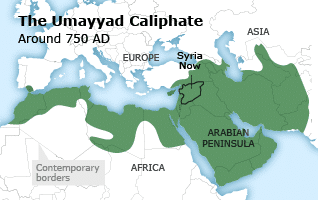
Introduction
In Justinian’s life and times, Christianity was the main religion in the Roman Empire. Within the religion, there were – almost from the very beginning – theological dissensions, even schisms, as well as power struggles, for instance between Rome and Constantinople.
The theological dissensions led to scissions, and thus the foundations were laid of the different churches that still coexist in present-day Syria and Lebanon.
At about the same time, Islamic conquerors, arriving from the Arabian Peninsula, appeared in the region. There had been Arabs in Syria for many centuries – although the origins of the Arabs are unclear, the first reference to their existence is an Assyrian cuneiform mentioning a certain Gindibu, coming from the land of Aribi in 854 BCE. The Arabs who came in the seventh century were different; they were followers of a prophet named Muhammad and called themselves Muslims, seeking to spread their religion throughout the region.

The Prophet Muhammad
Muhammad ibn Abd Allah, who was to become the founder of Islam, was born in Mecca in 570 CE. In 613 CE, after he had his first revelations, Muhammad started preaching. In 622 CE, he and his followers were invited to move to Yathrib (later renamed Madinat al-Nabi – City of the Prophet, or Medina). This move, the Hijra (Emigration), and the year in which it took place, 622 CE, became the starting point of the Islamic calendar.
The Hijra also was the starting point of the nation-building that Muhammad undertook – with success, although it took him almost ten years. From Medina, he conquered the whole of the Arabian Peninsula and united the Arabs under the banner of Islam. Jews, Christians, and Zoroastrians – as People of the Book (Ahl al-Kitab) – enjoyed the freedom of religion.
After the Prophet’s death in 632 CE, his followers continued his mission. Although there were tribal conflicts in the Arabian Peninsula, the conquest of the regions to the north was relatively expeditious, for several reasons. Firstly, the Byzantine Empire had been weakened by wars and internal conflicts, and the population in Asia Minor was weary of its rulers. Secondly, the Arabs deployed friendly tribes – related to those already established in the region – to conquer these populations. The first dynasty of caliphs to govern these regions, the Umayyads, who governed from Damascus, was quite tolerant toward Jews and Christians.
Umayyads
Abu Sufyan, a descendant of Umayya ibn Abd Shams, was a leading figure in Mecca in the 7th century, who, after first opposing Muhammad, adopted Islam later in life.
His son Muawiya, the first governor of ‘Greater Syria’, became the first Umayyad caliph after having emerged victorious over Muhammad’s

descendants Hasan and his brother Husayn, sons of Imam Ali, whom the Shiites to this day venerate as the Prophet’s only legitimate successor.
The wars continued intermittently despite a treaty between Muawiya and Emperor Constantine IV. The war against the Byzantines flared up especially under the fifth Umayyad caliph Abd al-Malik ibn Marwan. However, despite these hostilities, culture, and art thrived in the caliphate.
The caliphs built splendid palaces and mosques, among which the Umayyad Mosque in Damascus, the center of the caliphate under the Umayyad dynasty. In the 8th century, Damascus became the most important intellectual and cultural center in this part of the world. The city produced scientists, astronomers, mathematicians, doctors, and philosophers.
More and more, Syria’s population composition turned into the mosaic that it remains to this day. Descendants of the Phoenicians, Persians, Romans, Greeks, Armenians, Assyrians, Jews, and others had settled there throughout the centuries. Under the Umayyads, Arabic supplanted the Syriac (Aramaic) and Greek, the common languages until then.
Islam became the dominant religion, but the Umayyad were tolerant toward Jews and Christians, certainly in the early stages. In the early days, the Great Mosque in Damascus, built on the site of an older Christian church, offered room for both the Muslim and the Christian faith.
Eventually, both the strength of the central government and the Umayyads’ tolerance toward Christians declined. In 750 CE, the Abbasid dynasty took over and relocated the caliphate’s capital to Baghdad.

